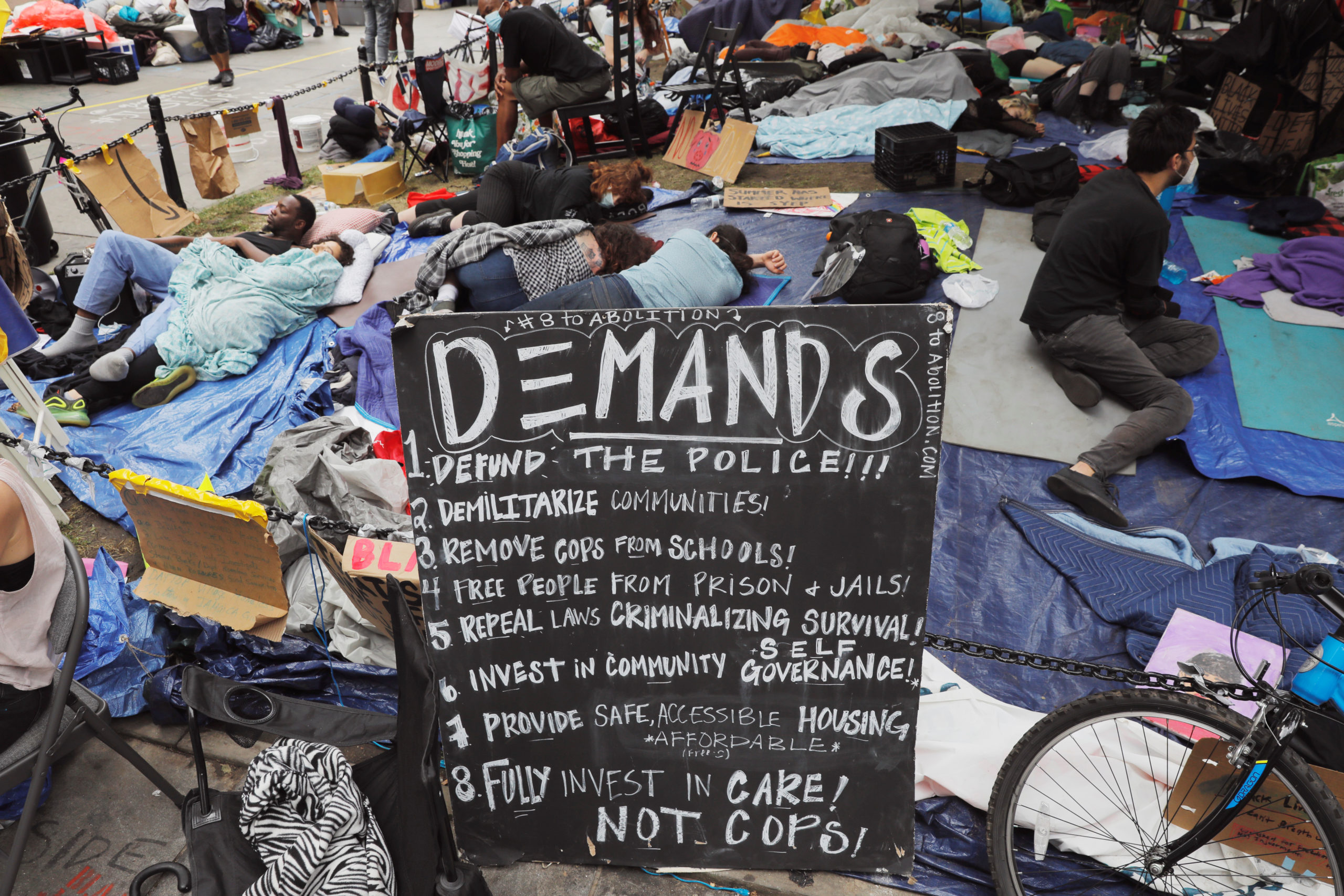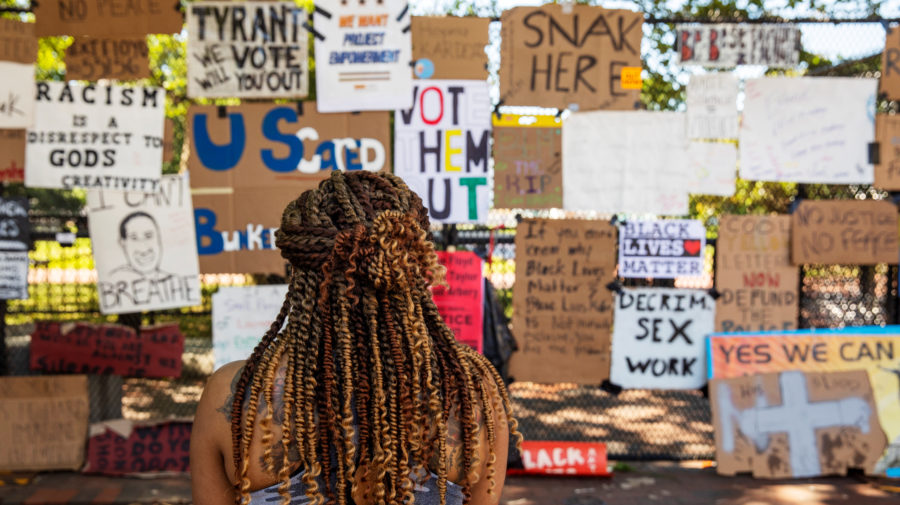Those who study misinformation are often asked to attribute misleading content to particular actors — whether foreign governments, domestic hoaxers, or hyper-partisan media outlets. Actors deliberately promoting disinformation should not be ignored; however, the recent US protests have demonstrated that focusing on specific examples of disinformation can fail to capture the complexity of what is occurring.
Following the killing of George Floyd, who died after three Minneapolis police officers kneeled on his handcuffed body, hundreds of thousands of demonstrators took to the streets around the world. At the center of their demands was justice for Black people who have died in police custody, and alternative criminal justice systems.
In the US, several accompanying narratives were heavily discussed online. Piles of bricks near protest sites had social media users across the ideological spectrum speculating as to their origin; false rumors spread that protesters in DC were targeted by an internet blackout. Elsewhere, images of police officers who joined marches or kneeled with protesters were distributed to and published by several news outlets uncritically and without examination of law enforcement’s motivation. These examples — along with the deeper investigations into the involvement of the white supremacist “Boogaloo” movement, or questions around what exactly is happening in the Seattle Autonomous Zone — all distracted from the reason for the protests.

Demonstrators relax inside of an area being called the “City Hall Autonomous Zone” that has been established to protest the New York Police Department and in support of “Black Lives Matter” near City Hall in lower Manhattan, in New York City, U.S., June 30, 2020. REUTERS/Lucas Jackson
When demonstrators began to organize in early June, one of the narratives debated online was the emphasis on “outside agitators” infiltrating the protests. Social media was full of posts that claimed undercover police officers, white nationalist militia members, or organized “antifa” members were responsible for instigating property damage or violence at the protests. Users posted photos of graffiti, claiming the wording was suspicious, and questioned whether it was intentionally placed to sow division.
But focusing on protest attendees who do not care about addressing police brutality distracted from the demands of organizers who do. The “outside agitators” here served a double purpose in attacking and undermining the protests. In the first instance, it defamed the protesters by attributing some of the violent behavior and destruction to their cause. And in the second, it distracted from that cause by turning attention away from the reasons behind it.
Misinformation researchers have coined the term “source hacking” to describe the process by which “media manipulators target journalists and other influential public figures to pick up falsehoods and unknowingly amplify them to the public.” The nature of the news cycle and the way news is reported mean many outlets could not avoid covering these narratives. Internal and external pressures, both financial and professional, would not allow it. And some of the accounts spreading these narratives, but by no means all, would have had malicious intent.
What these narratives demonstrated is that the story of the swirling misinformation surrounding the protests is not one with a central villain or organized network of insidious actors. Instead it is a story of how the modern information landscape, made up of news media, social media, and the people who consume media, is vulnerable to manipulation that influences the ways in which events are shaped and discussed. The “source hacking” that occurred in many of these instances was an organic side effect of the complex information landscape, rather than an intentional ploy. This is perhaps even more difficult for decision makers to navigate, and requires careful consideration on the part of news outlets and journalists to determine how to most effectively center the audience’s needs in what is reported.
In today’s lesson of, “The cops probably did this.”
Can you guys tell me what is wrong with this image and who could have done this? pic.twitter.com/BinKwnZYjm
— Mightykeef (@MightyKeef) June 1, 2020
After all of our social media monitoring during the protests, it is not possible to blame the “outside agitator” narrative on one bad actor. Our analysis is still ongoing, but as with any moment of shared online attention, bots and sock puppet accounts were very likely to have been pushing out content related to those narratives of protest infiltration. And journalistic mistakes were made: There are examples of outlets poorly framing or mis-contextualizing rumors, giving “outside actors” more legitimacy than the evidence indicated. But identifying insidious networks and media missteps is futile without a simultaneous examination of how our current information landscape is so easily influenced by these disturbances.
Social media platforms and their algorithms, editorial decision making, and determinations about what to post and share on an individual level all contribute to the visibility of certain narratives, and they work unintentionally in synchrony — often to undesirable results. For example, news outlets used valuable resources investigating a 75-year-old police brutality victim’s ties — or lack thereof — to “antifa,” thanks in large part to the promotion of this false rumor by President Donald Trump. This is just one example from the protests when news outlets spent many hours having to investigate and debunk claims from politicians, police authorities and video evidence from the streets. When newsrooms, particularly local newsrooms where staff are being laid off and furloughed, are focused on this type of work, they are less able to focus on stories that reflect the experiences and needs of their communities. And yet it is difficult to argue that topics exploding on social media are not newsworthy. The feedback loop between social media and traditional media is broken, and the protests exhibit how damaging that has become.
While the process of misinformation monitoring — locating a piece of false or misleading content and finding the originator of it — is still useful, and fact checkers play an important role in maintaining a healthy information ecosystem, what is becoming increasingly clear is that we must tackle the problem with misinformation from a macro perspective. It’s no longer enough to tackle each ‘atom’ of misinformation. Misleading narratives sometimes flourish in the modern information ecosystem because of a confluence of circumstances, not because of a well-executed plan. Mitigating misinformation whack-a-mole style will be ineffective if we do not address the infrastructural problems that define the way people receive, process, and share information with their own networks. For journalists, this means carefully examining the urge to report on and debunk specific pieces of misinformation. Any effort to do so should be balanced by robust solutions journalism, emphasizing social issues affected or manipulated by misinformation.
Historically, media criticism has focused on gatekeepers. Do legacy news outlets foster sources that understand the communities on which they report? Are they irresponsibly or unintentionally amplifying particular voices? These questions are still relevant, but the internet has dramatically widened the pool of who can disseminate information to the public, and media scholars must adjust their lens. As a result, it’s more difficult to understand the reasons behind poor story framing. An individual Twitter user sharing information about suspicious protest attendees or promoting the “outside agitators” narrative does not obfuscate the reason for the protest by itself. And yet, as part of a groundswell covered by prominent news outlets, their tweets likely contributed to that happening. The questions journalists need to ask are not only “who is responsible” or “how do we stop misleading narratives.” Now, perhaps more than ever, newsrooms need to think about how we ensure our audiences and journalists are prepared to navigate a media landscape so susceptible to gaming and manipulation.
Jacquelyn Mason, Diara J. Townes, Shaydanay Urbani, and Claire Wardle contributed to this report.
Stay up to date with First Draft’s work by becoming a subscriber and follow us on Facebook and Twitter.






